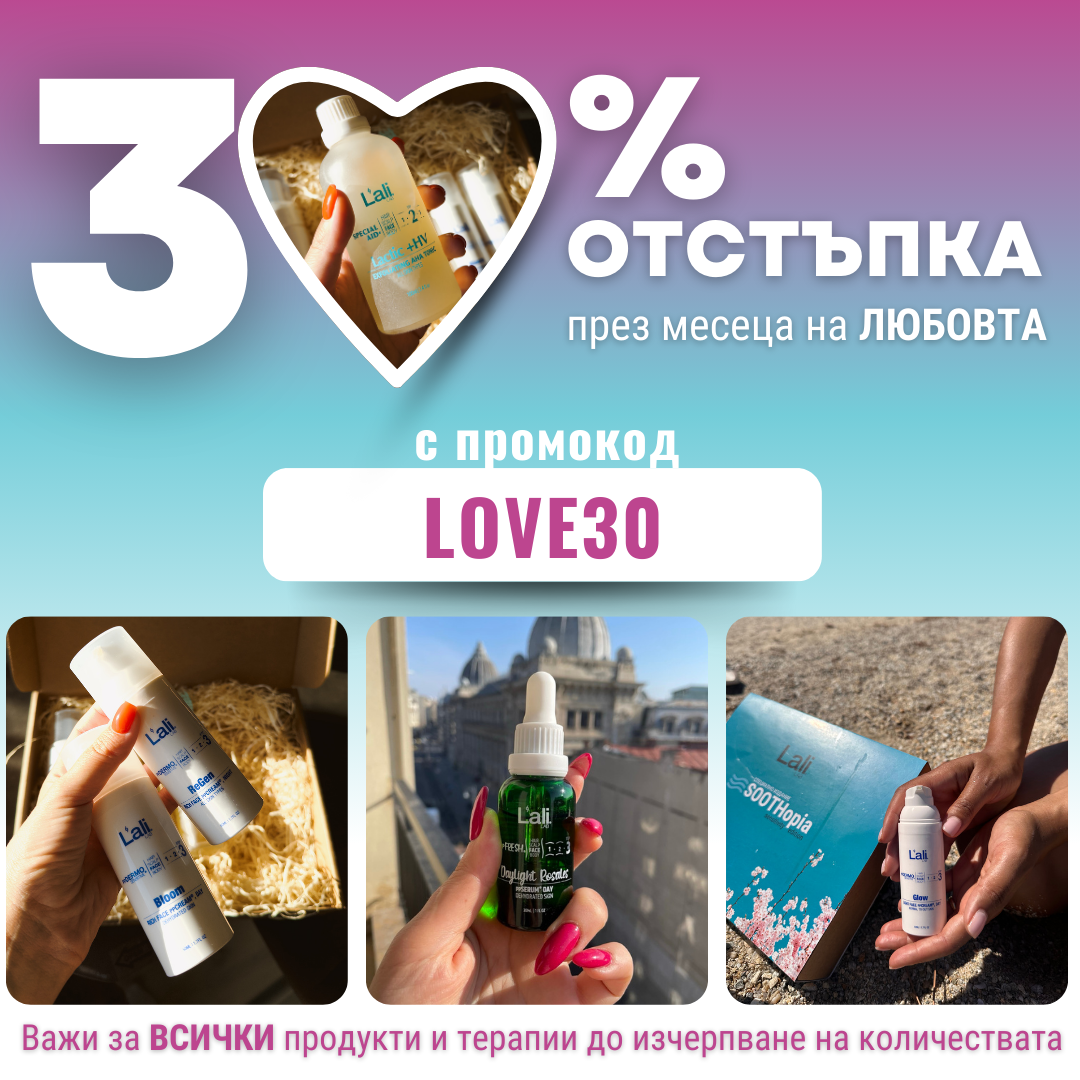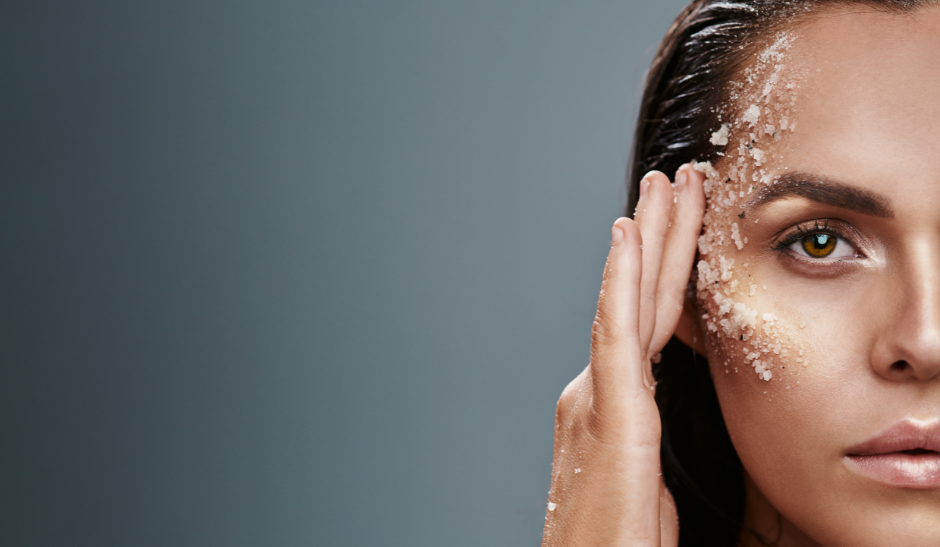Informed consent, IQ: I-question
Exfoliation – anti-aging care for any skin type
What
What is the exfoliation process?
What
What are the benefits of exfoliation?
✓ Prevents pore clogging resulting in less inflammation, pimples, blackheads and less visible pores
What
What types of exfoliation are there?
According to the type of particles used, exfoliation can be divided into two large groups: mechanical and chemical.
Mechanical exfoliation


Exfoliating tools:
brushes, files, sponges and gloves


Not suitable for sensitive skin!
Chemical exfoliation
This method uses different molecules – hydroxy acids, retinol and enzymes to renew the skin. While mechanical exfoliants can help improve the appearance of the skin, chemical exfoliation can provide much more effective results and, when used correctly, is much milder and gentler on the skin. Its mechanism is rooted in stimulating the exfoliation of epidermal cells from the stratum corneum, interfering with the connection between them. This leads to „softening“ of dry and rough skin and promoting cell renewal. Thus, they are more easily removed and allow new fresh layers of cells to emerge.
Organic acids:
AHA, BHA
Hydroxy acids, also called fruit acids, have been used in the treatment of skin diseases for about 40 years. They are some of the most widely used and researched compounds in antiaging skin care. Clinical trials have shown the effectiveness of these ingredients in reversing the effects of aging and reducing wrinkles, increasing skin elasticity, tone and hydration. Alpha hydroxy acid (AHA) and beta hydroxy acid (BHA) are the two main classes of hydroxy acids.
AHAs are used in the treatment of certain skin conditions such as acne, scarring, pigmentation, dry skin and wrinkles. They are involved in metabolic pathways and essential cell cycles. AHAs work at both epidermal and dermal levels. Originally used to treat hyperkeratosis and other skin conditions affecting cell renewal, AHAs have been found to help make skin softer and smoother, reduce wrinkles, lighten age spots and reduce inflammation.
Lactic acid (LA) is among the most popular AHAs in the cosmetics industry. It can be used in low concentrations (up to 9-10%) in cosmetic products for daily use and high (over 30%) – for professional care in beauty salons and dermatological clinics.


Beta hydroxy acids (BHAs), such as salicylic acid, are very similar to AHAs, with the main difference being their solubility. BHAs are lipid (oil) soluble unlike AHAs which are water soluble. This property allows them to penetrate the skin through the sebaceous glands, making them suitable for people with oily and acne-prone skin, penetrating deeply and breaking down the sebaceous blockages in the pores (comedones). In addition to the proven anti-inflammatory effect of BHA, they are proven to be low-irritant and can be used by people with sensitive skin. Beta hydroxy acids in skin care products work best at a concentration of 1-2%.


Enzymatic exfoliation
Enzyme exfoliants are a relatively new class of skin care products. As the name suggests, they exfoliate using highly specialized and purified enzymes. Like most AHA and BHA acids, the enzymes are of plant origin and the effects of the two types of exfoliants overlap to a large extent. While hydroxy acids are small molecules with non-specific action, enzymes are large protein molecules that target a specific group of similar substances, and sometimes just one. This makes them „trained“ fighters in the fight against the signs of aging. Due to their targeted action, they do not affect the surrounding structures, which makes them extremely suitable for people with sensitive skin.


Retinol and its derivative forms
Retinoids are a class of active ingredients derived from vitamin A. They are used to soothe sun-damaged skin, minimize signs of aging, treat acne, reduce fine lines and wrinkles by increasing collagen production and stimulating the production of new blood vessels in the skin, which improves skin tone. Additional benefits include lightening blemishes and softening rough skin. Due to their wide variety, the choice of products containing retinoids is difficult, and their slow action further limits their use. Some of the forms are classified as medicinal products, which is why a doctor’s prescription and supervision are required when using them.


How
How to choose?
It is now clear that exfoliation should be an integral part of our daily beauty ritual. But given the huge variety of methods and products, how do we choose?!
Avoid strong friction and mechanical exfoliation methods. They will further irritate your skin and may cause redness. Use a mild chemical exfoliant applied to a cotton pad or gentle reusable cloth. Apply in the evening, starting with a product with a low concentration (max. 5% AHA) 2 times a week and gradually increasing to daily use. Remember that it is normal for your skin to redden for a few minutes and to feel a slight stinging sensation, but if the effect lasts more than 10 minutes, remove the product immediately. Always finish the ritual with a rich moisturizing product, and in the morning use a sun protection product as a finishing care!
Normal skin is usually resistant and undemanding to the exfoliation method. Choose according to your preferences, remembering that chemical exfoliants have the best effect if applied every night, while mechanical ones should not be used more often than twice a week.
Exfoliation is extremely important for dry or flaky skin. Avoid mechanical exfoliation because the process is relatively aggressive and can lead to micro-injuries. AHAs are very effective for dehydrated skin. Lactic acid will help remove dead cells located on the surface of the skin and moisturize the inner layers of the healthy skin. Use AHAs every night, not forgetting to complete your beauty and health ritual with a rich moisturizing product, and in the morning use a sun protection product as a finishing care!
People with oily skin struggle with excessive sebum production, which leads to pimples, inflamed areas and clogged pores. Mechanical exfoliation up to twice a week can be very suitable, as long as the skin is not inflamed at the time. Use scrubs and masks containing brown or green clay, gently rubbing them onto the skin in a circular motion for best results. For deeper exfoliation, use AHA or BHA acids, with lactic and salicylic acids being best for people with oily skin. You can use them in the evening as part of your evening ritual. After removing the dead layer of cells, nourish your skin with a suitable cream or serum, and during the day don’t forget the sunscreen product.
Due to the specificity of this skin type, the choice is mostly based on the skin’s current needs. For daily exfoliation and maintaining the good condition of acne-prone skin, it is best to choose AHA or BHA acids as part of your evening ritual. Once a week, for calm, non-irritated skin, it is good to use a mechanical scrub mask containing activated carbon. It will dry the skin and remove excess sebum, thus limiting the growth of acne-causing types of bacteria. As a finishing care, always use products formulated for acneic skin!
Combination skin is characterized by both oily and dry areas, and this determines the possibility of using different types of exfoliants in different areas of the face. Applying combined scrub-masks to the whole face or alternating chemical AHA exfoliating products with mechanical ones is suitable. Never use both types on the same day as this can cause skin irritation.
If you still don’t know what to choose, trust Personal Diagnostics by L’ali.
Who
Marks R, Leyden JJ. Dermatologic Therapy in Current Practice. Martin Dunitz; 2002
Green B. After 30 years … the future of hydroxyacids. J Cosmet Dermatol. 2005
Leyden JJ. Therapy for acne vulgaris. N Engl J Med. 1997; 336
McLoone P, et al., Honey: A therapeutic agent for disorders of the skin, 2016
Oakley A., Alpha hydroxy acid facial treatments, 2017
Zheng Y, et al., Clinical evidence on the efficacy and safety of an antioxidant optimized 1.5% salicylic acid (SA) cream in the treatment of facial acne: An open, baseline-controlled clinical study, 2013
Tang S-C, et al., Dual effects of alpha-hydroxy acids on the skin, 2018
Photo: Alesia Kozik



